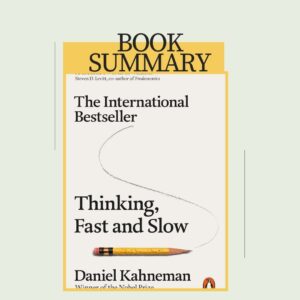Thinking fast and slow summary
In the realm of decision-making, cognitive psychology, and behavioral economics, the book Thinking, Fast and Slow stands as a seminal work that delves deeply into the intricate processes of the human mind. Written by renowned psychologist Daniel Kahneman, a Nobel laureate, along with his collaborator Amos Tversky, the book presents a groundbreaking analysis of how humans think and make decisions.

Table of Contents
The importance of decision-making process and thinking styles
- Decision-making is a fundamental aspect of human behavior and plays a crucial role in our everyday lives.
- Understanding the various thinking styles that influence our decisions is essential for improved cognitive processes and better outcomes.
- The book explores the fascinating world of cognitive biases, heuristics, and the intricate mechanisms that shape our choices.
Key Points:
- Cognition: The process of acquiring knowledge and understanding through thought, experience, and the senses.
- Daniel Kahneman: A prominent figure in the field of behavioral economics and cognitive psychology, known for his research on decision-making processes.
- Heuristics: Mental shortcuts or rules of thumb that simplify decision-making processes.
- Biases: Systematic patterns of deviation from rationality in judgment, leading to inaccurate perceptions or decisions.
- Nobel laureate: An individual who has been awarded the Nobel Prize for their significant contributions to a particular field.
By exploring the interplay between intuition, rationality, and cognitive processes, Thinking, Fast and Slow offers valuable insights into how we can navigate the complexities of decision-making and enhance our thinking abilities.
A Dual Process Theory: Understanding System 1 and System 2
In the realm of cognitive psychology and decision-making processes, the concept of a dual-process theory has gained significant prominence. Proposed by Nobel laureate Daniel Kahneman and his colleague Amos Tversky, this theory delineates the cognitive operations of human thinking into two distinct systems – System 1 and System 2. Let’s delve deeper into the foundational aspects, examples, and implications of this dual-process theory.
System 1: The Intuitive Fast Brain
Intuitive thinking can be likened to the fast and automatic cognitive processes of System 1. These processes are rapid, effortless, and triggered by cues in our environment, often yielding quick and instinctive responses. Here are some key characteristics of System 1 thinking:
- Heuristics: System 1 operates on mental shortcuts or cognitive heuristics to make swift judgments and decisions, relying on past experiences and stereotypes.
- Stereotypes: Rapid associations and generalizations based on societal norms or personal beliefs guide System 1 thinking, shaping our initial perceptions and responses.
- Automatic Responses: System 1 is prone to generating automatic and involuntary responses without much conscious deliberation, leading to potential biases and errors.
- Cognitive Illusions: This fast brain tends to create cognitive illusions where what seems intuitive or obvious may not always align with reality, highlighting the inherent limitations of System 1.
- Error-Prone: Being susceptible to various biases and subjectivity, System 1 can result in errors in judgment and decision-making, especially in complex or novel situations.
System 2: The Deliberate Slow Brain
Contrary to the rapid and instinctive nature of System 1, System 2 represents the conscious and effortful mode of thinking characterized by deliberate reasoning and logical analysis. Here’s an insight into the key features of System 2 thinking:
- Rational Thinking: System 2 engages in rational and logical thought processes, employing analytical tools and critical reasoning to arrive at well-informed conclusions.
- Conscious Mind: This slow brain involves the conscious awareness and active engagement of cognitive resources, requiring mental effort and concentration.
- Energy-Consuming: System 2 thinking is energy-consuming, demanding significant cognitive resources and attention to perform complex tasks or solve intricate problems effectively.
- Effortful Mental Activities: Complex computations, statistical analyses, and tasks necessitating deep cognitive engagement fall within the domain of System 2, emphasizing its more deliberate nature.
- Logical Reasoning: System 2 excels in statistical thinking and logical deduction, making it invaluable for tasks requiring precision and accuracy.
Interplay Between System 1 and System 2
The dynamic interplay between these two cognitive systems shapes our patterns of decision-making and information processing. While System 1 offers intuitive responses based on quick assessments and automatic associations, System 2 acts as a check and balance mechanism, allowing for deeper reflection and deliberation. Understanding the strengths and limitations of each system is pivotal for optimizing our cognitive processes and enhancing decision-making outcomes.
By recognizing when to rely on the fast and efficient responses of System 1 and when to engage the controlled and analytical processes of System 2, individuals can foster a harmonious cognitive balance that leverages the unique strengths of both systems. This cognitive synergy paves the way for more informed judgments, strategic decision-making, and enhanced critical thinking across various domains of life.
Frequently Asked Questions (FAQs)
What is the main concept of Thinking, Fast and Slow?
Thinking, Fast and Slow explores the two systems of thinking that drive human cognition: System 1, which is fast, intuitive, and automatic; and System 2, which is slow, deliberate, and logical. The book delves into how these systems interact and influence decision-making processes.
What are examples of System 1 thinking from Thinking, Fast and Slow?
System 1 thinking involves quick, automatic responses without much conscious effort. Examples include making snap judgments based on stereotypes, relying on heuristics for decision-making, and falling prey to cognitive biases such as availability bias or anchoring.
How does System 2 thinking differ from System 1 thinking in Thinking, Fast and Slow?
System 2 thinking is characterized by deliberate, analytical, and effortful mental activities. While System 1 operates automatically and is prone to biases, System 2 involves rational and logical decision-making processes that require conscious effort.
What are some practical applications of the concepts discussed in Thinking, Fast and Slow?
The concepts from the book can be applied in real-world scenarios to improve decision-making, problem-solving, and critical thinking. By recognizing the interplay between System 1 and System 2 thinking, individuals can make more informed choices, avoid cognitive biases, and approach complex problems with a rational mindset.
How influential is Thinking, Fast and Slow in the field of cognitive psychology and behavioral economics?
Daniel Kahneman, the Nobel laureate author of Thinking, Fast and Slow, along with Amos Tversky, has significantly impacted the fields of cognitive psychology and behavioral economics with their research on decision-making processes. The book remains a seminal work that continues to shape our understanding of human behavior and judgment.
Conclusion:
Thinking, Fast and Slow provides a profound exploration of the intricate workings of the human mind and the dual systems that govern our thinking processes. By examining the interplay between System 1 and System 2 thinking, readers can gain valuable insights into their decision-making abilities, cognitive biases, and strategies for improved judgment. This influential literature by Nobel laureate Daniel Kahneman remains relevant today, offering practical applications for navigating the complexities of daily life and enhancing our mental capabilities.




